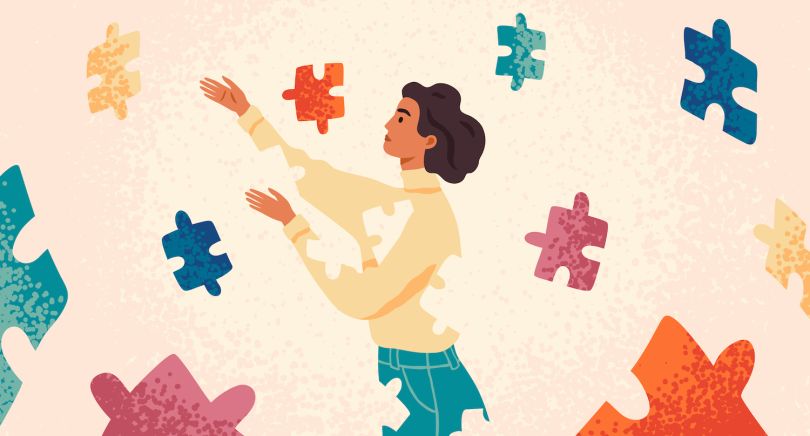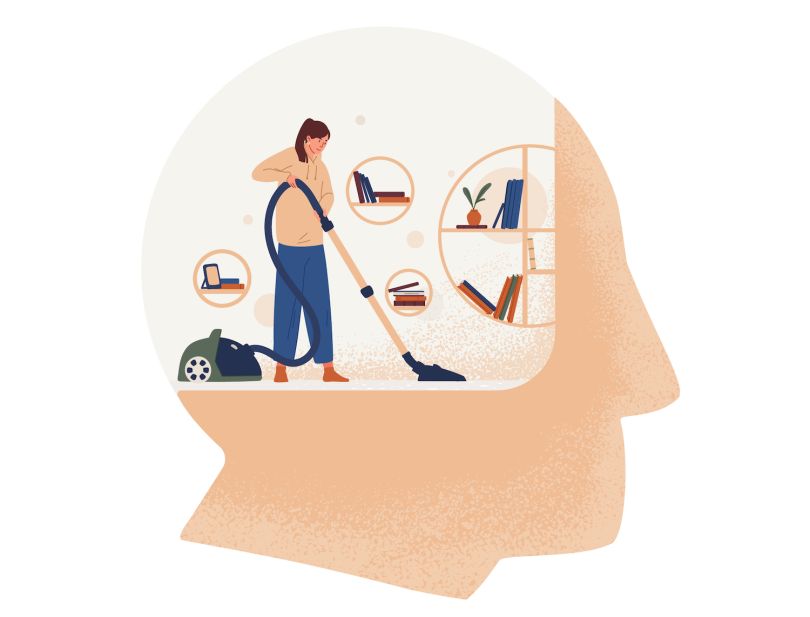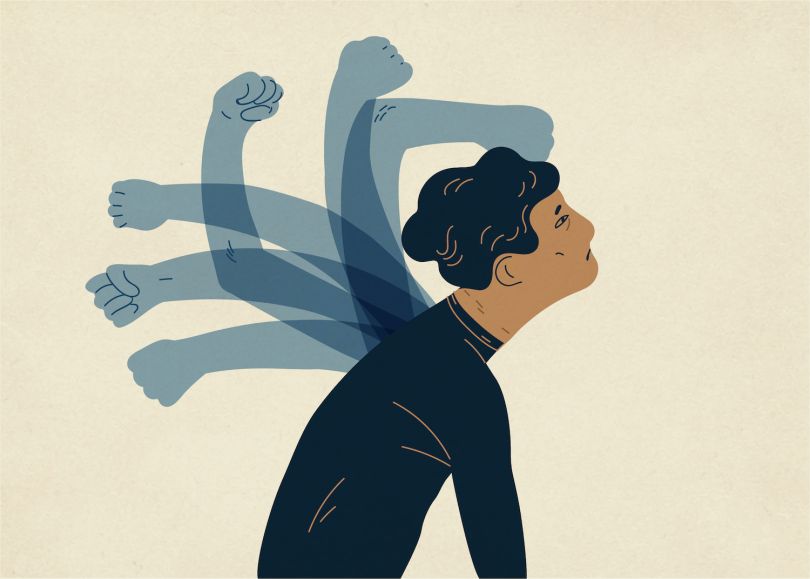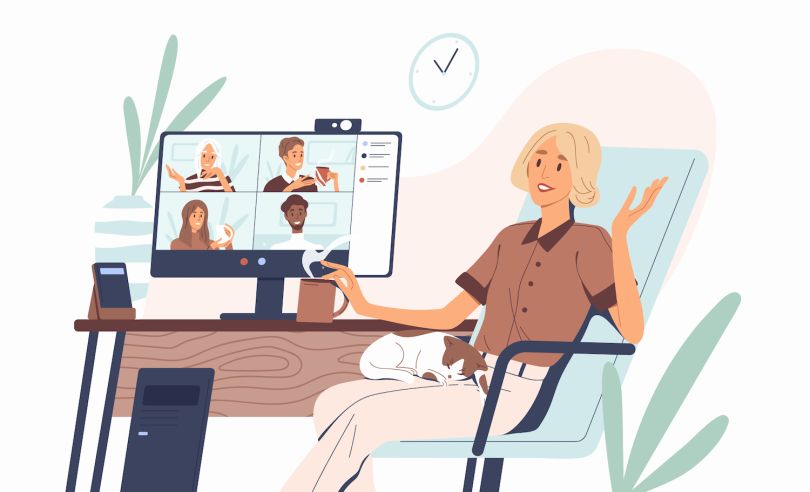Wake up at the same time every day. Put on a nice shirt. Take a brisk walk. If there’s still time before work, build an elaborate birdhouse.
If I had a dime for every mental health tip my social media feeds have served up since I started working remotely, I could buy a new brain.
The cute illustrations and pastel-toned infographics usually make me mad. How dare you tell me to put on a nice shirt when there is currently a straw wrapper stuck in my hair? In other moments, the content makes me feel better — maybe whoever doodled that picture of a happy woman in a collared shirt was feeling like I’m feeling.
About two weeks after much of America’s workforce switched to remote set-ups, Google search traffic for “symptoms of anxiety” hit an all-time high. Office life has its stressors, but our own homes seem to be giving the conference room a run for its money. For people with existing mental-health conditions — or without the childcare, technology, space, healthcare or employer support they need to work from home successfully — that dynamic is amplified.
Of course, this isn’t normal remote work. Shelter-in-place procedures isolate employees from family and friends, while social and economic unrest compound fear and uncertainty. Remote work itself, meanwhile, has been shown to improve productivity and employee satisfaction.
If this temporary shift leads to widespread remote work in the future, will that make our brains healthier, or will we all feel more alone more often?

What Does the Switch to Remote Work Mean for Mental Health?
Our jobs affect our mental health no matter where we do them. But is there some special relationship between remote set-ups and mental-health challenges?
According to author and former clinical psychologist Dr. Alice Boyes, the answer is yes. But it’s not because you’re at home. It’s because nobody is dictating when you show up, how you dress, where you sit, when you eat and how you work.
Habits are an integral part of maintaining a healthy brain, she said. In traditional offices, employers do a lot of that work for us. At home, it’s every person for themselves. And many of us have very short resumes when it comes to building habits from scratch.
That’s why those mental-health infographics keep telling me to wake up, put on a wedding dress and do 200 jumping jacks: It’s about the structure, not the particulars.
“People will say stupid things like ‘wear your work clothes at home.’”
“People will say stupid things like ‘wear your work clothes at home,’” Boyes said. “But those work clothes are really just a cue to tell your brain it’s time for focused work. Any other cue would work just as well.”
Remote work doesn’t only disrupt our routines, Boyes said. It disrupts our coping mechanisms, or the thoughts and behaviors we use to deal with stress. For example: Your old desk might have been next to the office meditation room, while your new desk is across from a broom closet that doubles as a litter box station.
And last, remote work disrupts our relationships. Office friends are the people many of us spend the most time with. We may not need them to get work done, but often, their presence makes our work better, Boyes said.
“Lots of people miss those small, random interactions with coworkers,” she said. “Less randomness means less creativity. That one-off conversation in the elevator can spark big ideas.”
That said, working from home can also come with some decided mental-health benefits. The most notable, Boyes said, is that employees don’t feel pressure to look like they’re working (unless their employers are using surveillance software, of course, which she discourages). This frees up employees to take restful breaks, or work during the hours they’re most productive.
Symptoms of declining mental health, according to Boyes
- Feeling irritable
- Difficulty concentrating
- Loss of appetite or difficulty sleeping
- Inability to get things done
- Losing interest in things you usually enjoy

Creating New Routines
Leanna Lee and Mike Veny host a podcast on mental health for freelancers. Since self-employed people often work alone, they need to devote extra attention to mental wellness. The same is true for remote workers, they said.
“If I don’t take care of myself, I’m kind of screwed,” Lee said. “You need to put mental health first, because otherwise it’s like a tower of cards.”
Lee, the owner of content marketing company Lost Lass, and Veny, a speaker and author, have found the blurred line between work time and personal time to be one of the most difficult parts of working from home. Without start-of-day and end-of-day routines, the workday can start the moment you roll out of bed and end when your eyes glaze over at 8 p.m.
Here’s Veny’s morning routine, which he admits to have stolen from an elementary school music teacher: First, he listens to three songs (and only three) while cleaning his desk and organizing his schedule for the day. Then, he drums on a drum pad. Last, he says some positive affirmations to himself out loud. For his end-of-day routine, he slides his chair under his desk. That means no more emailing until tomorrow.
“Some people right now are finding out that working from home is the best thing ever, and some never want to see the insides of their homes again.”
Lee’s morning routine is simpler — tea and alone time. She has an end-of-day ritual as well.
“My husband and I actually have a joke where I pretend to clock out. I’ll take my little pretend name card and punch myself out,” she said.
Talking with family members or roommates about your needs and expectations is important as well, they said. Describe your routine to the people in your house so they can support you, and do the same for them, Lee said. Lee is a morning person, while her husband is a night owl, so they work together to make sure each of them can work while they’re feeling most productive.
“If he needs to get started on a project, maybe I’ll take on more of the chores that day,” she said. “If I have a deadline to meet and I had to just wake up and start the day, he knows I’ll probably burn out a little quicker than usual.”
Veny also uses exercise to maintain his mental health. Exercise isn’t the answer for everyone — “I do not excel in it, but I admire his commitment,” Lee commented — but physical activity has been shown to help with conditions like anxiety and depression.
All in all, each person’s adjustment to remote work will be different. It can come with mental-health benefits: more mobility, more autonomy and, often, better work-life balance. But it also can be difficult and isolating.
Examine your initial reaction to remote work, Veny said: Are you feeling bad because you’re working at home, or because you suddenly have time to reflect on things you didn’t reflect on before? And remember that remote work is like Junior Mints or electronic dance music — not for everyone.
“Some people right now are finding out that working from home is the best thing ever,” Lee said. “And some never want to see the insides of their homes again.”

Battling Loneliness
Loneliness was a problem for American workers even when most of us were in offices. Young singles often focus on romantic relationships and their careers, letting friendships take a back seat, Neal Roese, a professor of marketing at Northwestern University’s Kellogg School of Management, told me. For partnered people with children, finding time for friendships gets even harder.
Roese co-authored a recent Harvard Business Review article about the importance of friendships for working parents based on research he’s conducting with Northwestern Ph.D. candidate Kyle Dobson. Research has shown that friendships are a critical component of mental and physical health, they wrote. And while working parents have an especially tough time making room for friendships, childless people aren’t immune.
According to Roese, social appointments like book clubs and happy hours cut into our personal time, which makes it hard to justify going. But what if we included friends in the things we have to do anyway? Roese calls this approach “bundling.”
“You’ve maybe heard the term bundling in a consumer context, which is when this or that packaged good might be bundled with another one at a cost discount,” he said. “You know, it’s like nacho night. Bundle up your salsa with your chips and cheese.”
Bundling for friendships is similar to nacho night. It’s putting in earbuds and talking with a friend while you grocery shop. It’s turning on FaceTime and connecting with old college roommates while you both cook dinner. It’s putting your cousin on speakerphone while she reads to her kids so yours can listen too, or starting a Slack channel for your friend group so you can share about your jobs during the workday.
“Sharing those more mundane life details allows you to make a deeper connection by letting that person into another part of your life.”
If this sounds exhausting, it could be because we’re used to putting on a show when we see friends, Roese said: We run down the highlight reel of kids and spouse and work, getting our friends up to speed. Bundling, however, can be more transparent. If you’re grocery shopping, talk about lemons and bread.
“We don’t want to bore somebody by telling them we had to clean the grout today,” Roese said. “But actually, sharing those more mundane life details allows you to make a deeper connection by letting that person into another part of your life.”
So, if meet-ups and happy hours — on Zoom or otherwise — are feeling more draining than nourishing, consider new ways to connect with people outside your home. For their research, Roese and Dobson are intervening in young people’s friendships to nudge them toward less structured forms of communication. Their hope is that casual, frequent and authentic conversations will lead to stronger relationships and less loneliness.
“That research is still very preliminary,” Roese said. “But it’s encouraging.”

Talking About Mental Health With Employers
When it comes to work-from-home contingencies, “I’m struggling with mental health” doesn’t have the same ring as “I have bad Wi-Fi.” Talking to managers or co-workers about mental health can be uncomfortable because of the surrounding stigmas — and many people who experience mental illness face judgment from others and from themselves.
“It feels like we’re admitting a weakness or something unprofessional,” Lee said.
“It feels like we’re admitting a weakness or something unprofessional.”
Pressed by a new generation of employees and mental-health advocates, many companies are taking steps to lessen that feeling, from encouraging employees to take days off for mental health to forming support groups. Despite that progress, 95 percent of employees have named other reasons like headaches when they take days off because of stress, a Mind Share Partners survey found, and two-thirds hide mental-health conditions from coworkers.
Whether or not your bosses realize it, taking days off for mental health benefits both employees and companies, as mental health affects productivity and retention. If you need to take time off, change your schedule or adjust some deadlines but aren’t sure how to talk about it with your manager, here are some suggestions from Lee and Veny:
How to Talk to Managers About Taking a Mental Health Day
- “I’m going through a difficult time.”
- “I’m dealing with a personal issue.”
- “I’m struggling with mental health this week. I’d appreciate your patience, as I’m running behind on some assignments.”
- “I’m taking a mental health day.”

How Employers Can Help
One-on-one check-ins, remote rewards programs and explicit communication about mental-health time off and benefits are good ways for employers to support remote workers’ mental health. But, according to Jeff Pfeffer, a professor of organizational behavior at the Stanford Graduate School of Business, those actions belie a more fundamental decision companies have to make: How much responsibility do they want to take for employees’ emotional and mental well-being?
Pfeffer studies, among other things, the effect of work environments on employee health and happiness. He said that, for decades, companies have been slowly shedding responsibility for employee well-being. He named “right-sizing” workforces, low investment in employee wellness and training, high turnover and the rise of gig work as evidence of this. A growing shift to remote work, however, could test companies’ relationships with their employees like never before.
“This could be another reason for companies to basically say, ‘You’re on your own,’” he said.
It doesn’t have to be like that. Companies can take responsibility for remote employees’ mental and emotional well-being in a few different ways, Pfeffer said. One is understanding that, as employees transition to remote positions, productivity will dip. It takes time to find new rhythms for work, family and the rest of life. If employees are working from home because of a crisis, expect productivity to stay lower than normal, and accommodate for that.
“If someone says you’re responsible for employee health, you may not know what the hell to do, but you’ll figure it out. You’ll deploy resources, you’ll get advice, and you’ll figure out how to make things better.”
Another is making room for family life in the virtual workplace.
“Many companies have tried to pretend that the kids don’t exist, that family obligations don’t exist, that work is work and life is life,” Pfeffer said. “That’s not true. So the companies that understand that and work toward what a colleague of mine calls ‘conciliation between work and the rest of life’ — places like Patagonia, like Cleo, like IDEO — probably are going to have a healthier and more successful workforce.”
Most importantly, Pfeffer said, companies can examine themselves and define their responsibility to employees. He can’t prescribe what that looks like, he noted. But if companies truly take on employee well-being and measure their success against the outcomes, smart leaders will figure out the best ways to support employee mental health.
“If I say I’m going to make you responsible for customer satisfaction, you’ll figure out a way to do it,” he said. “If someone says you’re responsible for employee health, you may not know what the hell to do, but you’ll figure it out. You’ll deploy resources, you’ll get advice, and you’ll figure out how to make things better.”
If you’re struggling with mental illness, you can call SAMHSA’s national hotline at 1-800-662-HELP. Veny also put together this list of immediate mental-health resources.




